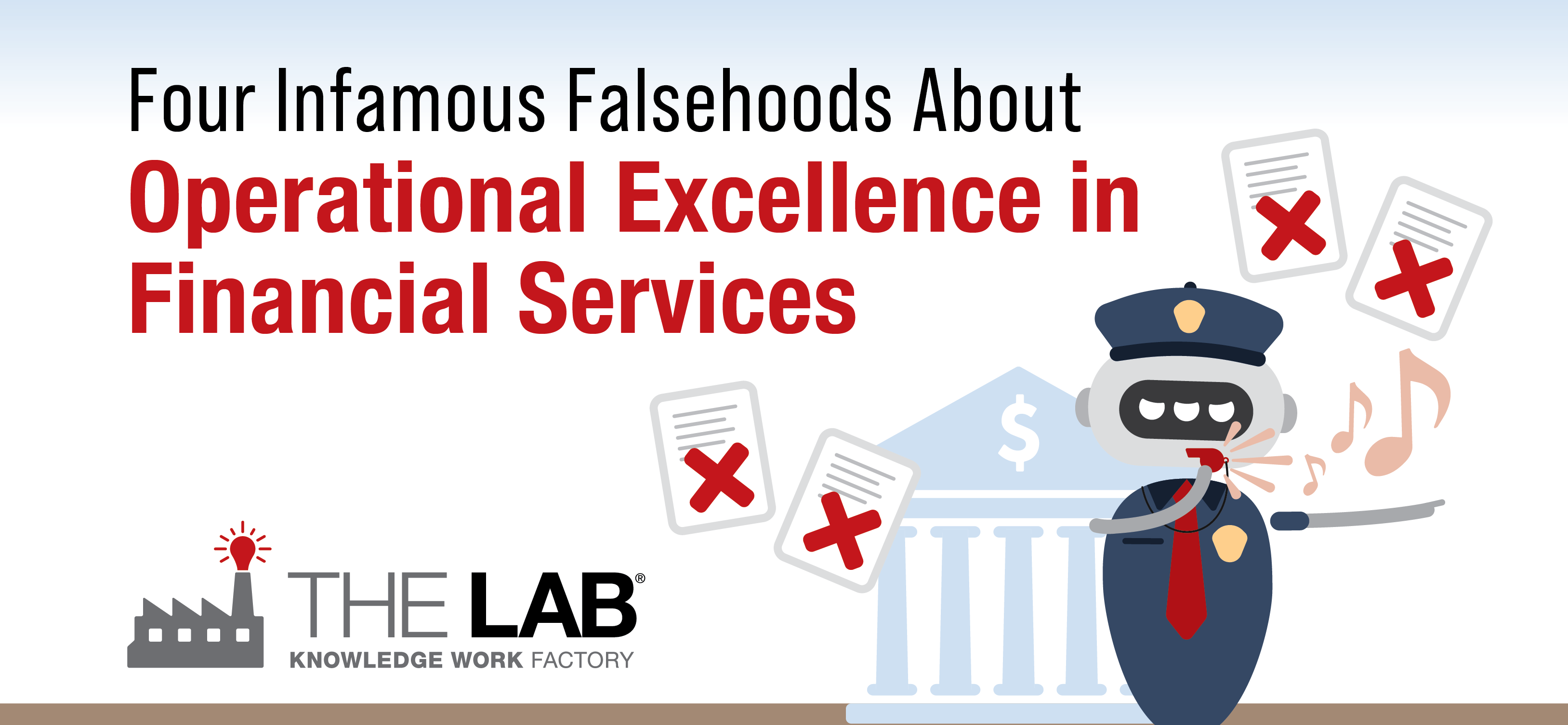Four Infamous Falsehoods About Operational Excellence in Financial Services
05/16/2017

Remember our last blog article? It was a case study which showed you how the challenges surmounted by a large Canadian bank could apply to yours. In this article, we’ll examine four persistent misperceptions—we call them “infamous falsehoods”—about operational excellence in financial services. They often contribute to bank-wide problems in the first place, such as needless downtime, duplicative work, and unnecessary over-service. Knowing about them can help you avoid them—or uncover them, if they’re already lurking within your bank.
Don’t believe us? Consider this one glaring example: We recently stopped into a retail branch of a large North American bank. Behind the counter sat three tellers. In the lobby… no customers. It’s a classic case of wasteful over-staffing, and a convenient lead-in to our story.
Infamous Falsehood 1: Operational excellence in financial services can’t be boosted at the branch level
The flawed reasoning goes like this: You simply can’t wring any more efficiency out of your branch network. Why not? Salaries are already low. Staffing models are already in place. Many banks tout “zero wait time” as perfection in customer service. It’s a mousetrap you can’t improve upon.
Wrong.
In reality, over-servicing customers won’t produce a competitive advantage. Most customers, in fact, have a better feel for the value a bank delivers—or doesn’t—than its executives do. They’ll wait, a short amount, for service. Simply adding 30 seconds of average wait time may go wholly unnoticed by customers. But, depending on the size of the branch network, this could add up to tens of millions of dollars saved in staffing costs. And it translates to true operations efficiency in banking.
How, then, do you fight against Infamous Falsehood 1? Start with a wall-to-wall study of non-technology work activities in your bank’s branches.
You’ll be amazed at what you find. New loan applications are routinely processed inconsistently and incompletely. This bloats branch staffing up to ten percent. It adds even more to the back office.
You may well also discover that customers receive incorrect information. All the time. This can include everything from documentation requirements to product features to branch operating hours. Finding and fixing these inefficiencies will increase the profitability and operational efficiency of public sector banks. And here’s an added benefit: It will deliver a more satisfying customer experience, too.
Infamous Falsehood 2: Operational excellence in financial services should never be attempted in the front office
It’s widely believed that a bank’s marketing and sales executives “own” the front office, and so tampering with it will take its toll on sales.
Again, wrong.
The front office is actually home to many of the bank’s most durable and robust business processes, all of which are ripe for improvement. The trick is to think of them as production processes—take an almost factory-like view. Seen in this light, lots of improvement opportunities will appear. For example:
- Front-office executives will usually resist efforts to partner with the back office to develop new products and services. And so the sales producers will often improvise. This, in turn, squanders countless hours on one-off solutions.
- A bank’s best revenue-generators frequently fail to pass along their winning ways. The tactics they’ve developed to become successful are kept locked away in their heads. But these are valuable best practices. They shouldn’t remain hidden, hopelessly diverse, and unsupported by facts.
Infamous Falsehood 3: The only way to boost the operating efficiency ratio for banks is through technology
When it comes to back-office operations, too many people in banking fall for the siren song of technology. They think it’s the best way to reduce the waste that’s lurking there.
We disagree. Non-technology improvements matter just as much. (And they cost a whole lot less.) In fact, barely-detectable inefficiencies add up. Left unaddressed, they can vacuum up a lot more productive time than new technology can save. So why not begin with the most basic and cost-effective approach to operations efficiency in banking?
Infamous Falsehood 4: Improving banking efficiency and productivity is more trouble than it’s worth
Too many people in banking today are intimidated by the prospect of finding and fixing all of these little inefficiencies. They don’t think it’s worth the effort. In fact, they’d rather simply write them off as the cost of doing business.
But that’s simply wrong. They’re an avoidable cost. They’re a cost that’s standing between you and outstripping your rivals. And they’re hardly impossible to locate or remedy.
Problems like the ones we’ve discussed in this article are often hiding in plain sight. The solution, then, is to analyze work at the granular level of activity. This is something manufacturers figured out a hundred years ago. And they’ve been improving upon this technique ever since.
Learn the lessons of standardization and simplification. And then translate them into superior operations efficiency in banking.
We hope you’ve enjoyed this article.
Consider this: All of these insights are based on real-life engagements that The Lab Consulting has had in the banking sector with the world’s leading financial institutions. And we can bring these same levels of success to your bank, thanks to our unique self-funding engagement model and irresistible money-back guarantee. Click here to learn more.
For 2021: We have updated our bank client offering. Much of these findings and implementation results can be reviewed in the 3-part-series of “Big Rocks for Banks” below. Find out how to strategically lower costs, increase operating leverage, improve customer experience, and automate what previously wasn’t automatable in your bank.
Find them all here:



